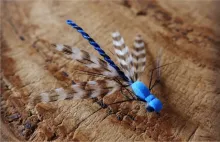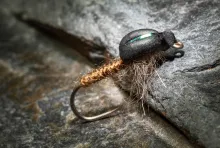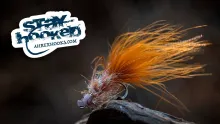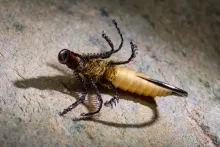Somewhat an oxymoron - a fly that's a mammal - but still a fun fly to tie, and not least to fish when the large fish are tuned in on a mouse menu.
The term "mouse fly" is kind of a contradiction and one of the types of flies that brings the word fly in fly fishing almost as far away from something flying as possible - still surpassed by shrimp flies not to mention crab flies, but anyway...
Meat and potatoes
Crazy or not, mouse flies are quite popular, and can be extremely productive. I have heard people call them meat and potato flies, and that actually tells quite a bit about the fly: the mouse can be a real producer, and for people fishing for fish for the pan, a mouse skated across the right stream in the dusk can help fill the stringer in a short time.
Those who are less keyed on filling the freezer, but like to catch big fish, can also give the mouse a chance, because mice are meat and potatoes to large fish - mostly meat of course.
Mice can catch large browns and rainbows, bass and pike as well more exotic fish such as taimen (huchen, Danube salmon). Fishing with mouse flies where it makes sense is usually very popular because of the intense surface action and the fierce attacks they can provoke.
Mouse years
Sometimes mouse flies is the one lure that really works. Certain areas and seasons where mice are present in large numbers, a mouse fly can be the key to success, especially during so called mouse years.
The term mouse year is well known from biology and ecology, and the phenomenon has been picked up by anglers all over the globe where there are mice and water.
It of course refers to years or seasons with an extraordinarily large number of mice on the move. These years often appear with certain intervals, but can also be coupled with food supplies, climate and other factors.
They are a natural imbalance in nature that let populations grow - often until they almost collapse due to lack of food and fierce competition amongst the many individuals of a species, which then diminishes and become way fewer the following season, and then start to rebuild in an almost regular cycle. Animals living off the mice follow this cycle with a delay, and less mice means less stoats, foxes and owls, which again means less pressure on the mice, which then thrive and propagate, and the cycle can repeat.
The swimming lemming
One of the most widely known "mouse" years is probably that of the lemmings, a small and pretty ill tempered rodent, which inhabits the arctic. It's known for its migrations during the boom years, which occur about every four years depending on outer circumstances.
The lemming populations fluctuate wildly, bringing them on the brim of extinction at times. But other years they are so numerous that they will try to disperse and run in huge numbers and cross streams and lakes with lots of potential trout and pike food as a result. Many drown, but a lot also get eaten by aquatic predators with eyes and mouths fixed upwards towards the surface and the swimming snacks.
Imitating a mouse
Basically a mouse is pretty easy to imitate. A cylindrical or pear shaped body and a long tail and you are there. Floating patterns generally work best, but even simply splashing a nearly sinking mouse fly into the water the right place, typically close to banks and overhangs, can do the trick.
Mice vary greatly in size, but the common mouse species are generally smaller than most people imagine, so don't worry too much about making big flies. Mouse flies will still be big flies no matter what, but an inch-long body and an inch-long tail will make a fine mouse imitation. Lemmings are a bit larger and have a short tail.
Color varies too, but the gray and tan specter is a safe choice. Lemmings are slightly more colorful with tan, rusty, and brown patterns, but a uniformly colored body in the right hue will most likely do. To the fish, the mouse is just as much defined by profile and action in the surface as it is by color and details.
The legs are of course visible on all these small rodents, in particular when they are frantically swimming to get across a current, but if you have the correctly shaped and maybe even furry but legless body, cast it upstream and twitch it across, it seems enough to trigger a strike - especially if it's dark.
To us humans the small, black, shiny eyes and cute little ears are also key traits to mice, but I doubt that the fish care much for eyes and ears. But sure enough: a mouse fly with ears and eyes - not to mention whiskers - will definitely sell better than the blind, deaf (and dumb?) mouse. And kids (and cats) love them...
And kids (and cats) love them...
There are many ways to make mice, and here's a few of the most common.
Foam
Foam mice are really an easy tie, and prefabricated bodies such as Rainy's Foam Mouse Bodies makes it even easier. I got mine through Danish The Fly Company.
You can cut or shape your own mouse bodies from foam sheet - either really thick stuff that lets you carve out a whole body, or from thinner layers glued together or from thin sheet that you roll. Another option is the Sidney Opera Mouse style where more or less open layers of foam are folded over a hook to create volume.
You can use foam in the desired color, but a batch of markers in tan, brown and gray can give white foam a very mouse like hue.
It's way easier to use cylinders and of course easiest of all to use the bodies that come ready to use right out of the bag. A bit of glue on a hook shank and poke it through the hole in the Rainy's Foam Body and you're basically set.
I have bought a length of cylindrical foam insulation AKA gap filler rod to be used filling the gaps between tiles - grouts - before you fill them with cement, silicone or whatever. It's perfect for shaping mouse bodies (or popper heads), and it's of course ridiculously cheap compared to fly tying material costing a few dollars for several feet, enough for hundreds of mice or poppers. This is a soft foam, and trimming it a bit to shape, cutting a slit in the bottom and securing it with a bit of glue and some thread wraps on a large hook will give you a nice mouse fly. Add a tail and call the cat!
Deer hair
Being a die hard muddler fan, the spun and sometimes trimmed deer hair mouse is my personal favorite mouse fly. It's a bit more cumbersome to tie than the foam body mouse, and has the disadvantages of the natural materials inasmuch as it gets drenched with water and becomes heavier as you fish it, but I still find it immensely charming and love tying them.
As with the foam mouse you can opt out on ears and eyes, but they sure do add to the childish joy when you look at the fly. Suede bits for ears and nylon eyes do a fine job, but be careful not to trim off anything if you decide to trim the deer hair. The easiest way to tie a deer hair mouse is simply to measure the hair before tying it it and letting the the tips stay on the finished fly. If you just flare the hair on the top of the hook shank and don't allow it to spin, you can get a mouse body, which has an almost perfect shape and a very mouse looking texture.
You can of course also go the the packing and spinning way where you spin and compress the hair to a dense body and trim it with scissors or a razor blade when it's done. This allows you to make some immensely dense bodies, almost solid and very well able to keep out water. If you give the finished body a bit of spray varnish when it's done, it's almost as water repellent as cork. You can add eyes and ears after the spun and trimmed body is done by gluing the eyes on and cutting slits for the ears.
Fur
A large rabbit zonker strip or a large hair hackle is also a way to form a mouse. The finished mouse will look very good when it's dry, but once you submerge it, it will soak water and become pretty soggy and heavy - a diving mouse.
It can still work as the "mouse that falls into the water", but once wet, it will sink and when you strip it, it will dive and swim underwater, very unlike any mouse trying to cross the water.
But these hair mice have also taken their toll of fish, and don't skip them just because they don't float.
Mixed materials
You can of course mix the materials and there are many patterns that combine materials. There are several example of patterns that mix fur/hair and foam like the Rydare Mouse, which uses rabbit and foam, and patterns like The Morrish Mouse, Frank Smethurst's Hemorrhoidal Mouse, Mr. Hankey and the Blair Mouse mentioned below, which all combine deer hair and foam in different ways.
The general idea of these hair and foam mice is a hair body for volume and a foam back for flotation. Many of these highly efficient contraptions just confirm that fact that a mouse fly doesn't have to look anything like a mouse to work.
Hooks for mice
As already mentioned you don't need the largest of hooks. Compared to many other trout flies the hook of course needs to be fairly substantial, but for pike and bass anglers the hook is small to average.
Since the finished fly is supposed to float, you want a hook with a thin wire, and depending on your quarry and the pattern you are tying, you want a hook with a large gape to clear materials and hook the fish properly.
Hooks in the 1/0, 2/0 and up to a 4/0 are great for mice. Go for a classic light wire streamer hook like a Kamasan B950u or the new Partridge Attitude Streamer hook. You can also use light wire stinger hooks like the Daiichi 2720.
Tying on a tube is an obvious choice for producing a large yet lightweight fly. When fishing for pike it also makes sense because you can reuse the hook if (when) the fly itself gets trashed.
Tail, ears, eyes, whiskers
You can choose to equip you mouse with all the paraphernalia that's expected on a mouse: a tail, ears, eyes and even whiskers.
I think the tail can be a key, but the rest is definitely not there to lure the fish, but will make your mouse more likable to anglers - young and old.
Tail:
The tail is a very easy part. It can be a piece of yarn, a piece of chenille (melt the tag end to seal it). I often use a foam scrap, which is slightly stiff, but makes a nice tail and is right at hand if you are using foam anyway. Skin or suede are obvious choices and a lot of recipes call for a zonker strip, which only has a small tuft of hair on the end, which forms a very cute and mobile tail.
Ears:
Ears can also be made of foam, but will be a little clumsy depending on the size of the fly and the thickness of the foam. On some patterns like Mr. Hankey the foam back can be cut with ears in the front. Suede is very naturally looking but also more difficult to shape and get tied in or attached. Thin, stiff but pliable plastic sheet is easy to work with and very easy to make look natural, but best for hard foam bodies or packed and trimmed deer hair bodies. Some tiers will let small tufts of deer hair remain when trimming spun bodies, but that technique requires some dexterity and care.
Eyes:
Most mice have pretty small, all black eyes, and melted monofilament is a very close imitation. Melt the end of some thick mono and coat it with LCR. A black marker or black varnish can add to the blackness. Large doll's eyes or other stick on eyes may look charming, but if you aim to imitate they are mostly far from the natural.
Whiskers:
Some mice have very distinct whiskers, but I seriously doubt that the fish discern between mouse imitations with and without whiskers. If you want to add whiskers, most stiff, tapered hair is suited for the purpose. Boar bristles, moose or similar hair will to. If you trim a deer hair body, leaving a few untouched hairs can also do it.
Thin mono is a very good and easy material to use. Use a sewing needle to pull it through dense material such as foam or packed deer hair, or tie long strands in before adding other materials, and avoid trimming until the mouse is finished where you can assess the proper length an trim.
Some tyers simply knot some pieces of mono or rubber legs around the hook shank when the fly is done just behind the hook eye or close to it on deer hair bodies. A dab of glue, varnish or LCR will secure them.
Fishing the mouse
Almost any mouse fly will require a sturdy rod, and something in the 7-9 weight can sometimes be called for if you are fishing a large mouse tied from natural materials. The dry mouse is a blimp with lots of air resistance, the wet mouse is as a bunch of door keys: heavy to lift off the water and get airborne.
You can grease the natural material mouse fly with silicone dry fly grease at the water or spray it with a spray varnish when it's newly tied. This will make it float longer and better and keep it from soaking up too much water.
The floating line is a very natural choice since we want the mouse to swim or at least stay close to the surface. A fairly short and heavy leader will help turn over the fly, and a rod length will usually suffice. We're not fishing stealthy here, but want to stir some commotion and get the big and hungry fish on the move. Noise is actually a key.
The classic mouse strategy is upstream and across and then stripping the mouse back in short jerks while it swims downstream, crossing the current. This is what a natural mouse would do. You can also fish downstream to get tension in your line and simply wiggle the rod while the mouse drifts across. That will look like mouse fighting its way against the current with hectic swim strokes.
The mice often splash noisily into the water close to the bank and immediately start swimming all the way across. The wisest of the mouse-killing fish are holding close to the undercut and overgrown banks where small, innocent mice jump in and won't see the fish hidden in the shadows. Other fish will wait in the open water and attack when the mice swim over after having launched from shallow water.
Dusk, night and dawn are traditional mouse times, and the larger fish have a tendency to prefer the shelter of darkness when on the prowl, but don't skip daytime fishing with mice, because fish also eat during the day. Strikes are often violent and splashy. The fish have to take the fast moving mouse in the surface, and that can be a heart pounding experience.
More on mice
- Log in to post comments

























I saw a mouse on you
I saw a mouse on your site, the only time I saw it was demonstrating a piece of equipment I think It was one of Marc Petitjean visesl Or maybe the regal. I have searched high and low for the patten. It is a really cute one, if I keep the little ones happy I get the time to tie what I want while they are playing with thearjeos .
I promised. All I really remember about it is it has discs that fit tightly together ti nake the body. We heed to make this one of these. I supposed I could try to duplicate it but would rather do it right the first time. Thanks for your time and effort,
Sean M. Mooney